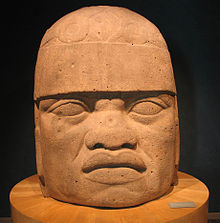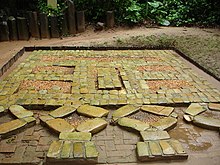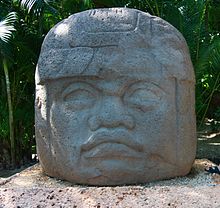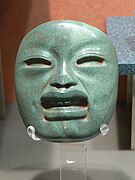Olmec culture
The Olmec culture was a civilization that developed during the preclassic period of Mesoamerica. Although vestiges of their presence have been found in large areas of Mesoamerica, the Olmec cultural area —metropolitan zone— is considered to cover the southeastern part of the state of Veracruz and western Tabasco. In this sense, it is necessary to clarify that the ethnonym Olmec was imposed on them by 20th century archaeologists, and should not be confused with that of the Olmeca-Xicalancas, who were a group that flourished in the Epiclassic at sites in central Mexico, such as Cacaxtla.
For a long time it was considered that the Olmec was the mother culture of all of the Mesoamerican civilization. However, it is not clear the process that gave rise to the artistic style identified with this society, nor to what extent the cultural features that are revealed in the archaeological evidence are the creation of the Olmecs of the nuclear area. It is known, for example, that some of the properly Olmec attributes could have first appeared in Chiapas or in the Central Valleys of Oaxaca. Among other doubts that are pending a definitive answer, is the question of the numerous sites associated with this culture in the Balsas Depression (center of Guerrero).
Whatever the origin of the Olmec culture may have been, the network of commercial exchanges between different areas of Mesoamerica contributed to the diffusion of many cultural elements that are identified with the Olmec culture, including the cult of mountains and caves; the cult of the Feathered Serpent, as a deity associated with agriculture, the religious symbolism of jade, and even the artistic style itself, which was intensely reworked in the centuries after the decline of the main centers of these times.
Political and social organization
The Olmecs created centralized political systems supported by religion and hereditary power that were unparalleled in other peoples. Olmec society came to develop a stratified social organization made up of: divine rulers, the aristocracy, and common people. The existence of a genealogy contributed the principles of social exclusion and hierarchy of lineages in order to legitimize the rulers and distinguish the elite from the rest. The power of the rulers was strengthened through religious concepts, beliefs, and practices, and entrenched through their privileged access to basic necessities, sanctuaries, and imported goods. It is one of the most outstanding and ancient societies of Mesoamerica, it is speculated that they established a policy that was characterized by its connection with the religious, for this reason it is considered a theocratic civilization. In fact, due to its great antiquity, the ethnic identity of its members is unknown.
Olmec settlement area
Despite the fact that the Olmec culture had a diffusion that reached most of Mesoamerica —except in the Western region, which followed a more or less autonomous cultural development until the end of the Preclassic—, one of the regions where The clearest evidence of the presence of this culture has been found in the southern part of the Coastal Plain of the Gulf of Mexico, between the Papaloapan and Grijalva rivers, which corresponds to the northern half of the Isthmus of Tehuantepec. Currently, this area corresponds to the southeast of the state of Veracruz and the west of Tabasco. It is an area with a warm and very humid climate, climatic conditions that this place surely also had in pre-Columbian antiquity.
The Olmec nuclear area is irrigated by mighty rivers that come down from the foothills of the Sierra Madre de Oaxaca and the Sierra Madre Oriental, such as the Coatzacoalcos, San Juan and Tonalá. Due to the humidity of the area and the sources of these rivers, in the rainy season the overflows of the currents are a constant. Although at present the vegetation of this region of the Mexican Republic has been extensively modified by the action of man, in the past it was covered by a thick tropical forest, which was the habitat of numerous species that are currently on the verge of disappearing in the Mexican territory, including the jaguar, birds with precious plumage such as macaws and quetzals; reptiles of various species, and mammals such as the tapir. The latter was considered by the Olmecs as a difficult animal to hunt and only the bravest attacked it because it was necessary to be very close to it since it was a complicated task to penetrate its thick skin.
The region has soils rich in humus and of considerable thickness. Crude oil sprouts on the surface of the ground among the vegetation. However, it lacks many of the materials that are characteristic of Olmec-style objects found in this area and in other parts of Mesoamerica. These include obsidian, jade, serpentine, and cinnabar. To obtain solid stone for their materials, the inhabitants of this region resorted to the quarries of the Sierra de los Tuxtlas —also known as Sierra de Santa Martha or San Andrés—, which provided them with basalt and other volcanic rocks that they used in the construction of temples and sculpture. However, these sources of stone materials are more than one hundred kilometers away from places like San Lorenzo and La Venta, which can give an idea of the level of organization required to move them —without pack animals and on a muddy soil—those monoliths that weigh in the tens of tons, to the political centers of the Olmec culture.
The word "Olmec" means "inhabitants of the rubber region" and was used by the Aztecs to name various ethnically and linguistically diverse peoples who occupied the region of Veracruz and Tabasco throughout the centuries. The name given to themselves by those whom we call Olmecs is unknown.
Under the term "Olmec" two realities have been grouped: a people from the Gulf region and an artistic style. The Olmec style can be seen embodied in rocks, caves, large and small sculptures, and clay objects found throughout Mesoamerica. From Jalisco to Costa Rica, passing through Guerrero, Chiapas, Oaxaca, the Central Highlands and the Gulf coast, images of jaguar children and other characteristics typical of Olmec art have been found. It is believed that the dispersion of this artistic style is due to the fact that the peoples of the Gulf created a wide network of exchanges with other distant populations. In this way, Olmec symbols and forms were integrated into the artistic expressions of other Mesoamerican areas.
Likewise, the "mother culture" of Mesoamerica is considered Olmec because in these first societies some cultural practices began that were fully integrated into the culture Mesoamerican, such as the use of an urban settlement pattern, the establishment of a theocratic society, the ball game, among others.
History
The earliest evidence of Olmec culture is estimated to date from around 3000 BCE. C., and the most recent are approximately 400 BC. C. The Olmec civilization was constituted mainly around 3 ceremonial centers: San Lorenzo, La Venta and Tres Zapotes, in addition to manifesting itself in other sites such as Laguna de los Cerros.
Saint Lawrence
The oldest Olmec center is that of San Lorenzo (approximately 1150 BC), Texistepec municipality, located in the Coatzacoalcos river basin, in the state of Veracruz. The beginning of the flourishing of Olmec culture at this site began around 1150 BCE. C., the period from which most of the sculptures and architectural elements that characterize the Olmec culture date, many of which are preserved on the site. San Lorenzo was sacked in the year 900 BC. C. and the monumental sculptures suffered an attempt to destroy them; some were buried, and others were transferred to the ceremonial center.
The Sale
It was the most important ceremonial center of the Olmecs. This ancient city stands out for representing the first planned architectural outline in ancient Mexico, its monumental earthen architecture, its great sculptural heritage and its jade offerings, as well as its massive offerings, unique in the pre-Hispanic world. In the surroundings of La Venta, cultural vestiges dating from 1750 BC have been found, although the main occupation is concentrated between 1200 and 400 BC. It has the oldest pyramid in Mesoamerica and heads have also been found. colossal statues and thrones, which deserve special recognition due to the fact that in order to build them, huge basalt blocks had to be transported from the Sierra de los Tuxtlas, tens of kilometers from there, since being a swampy and sandy area, there is no there were stones. It is believed that it could have housed up to 20,000 inhabitants in that place.
The Three Zapotes
The ceremonial center of Tres Zapotes was the last to be developed. It is the best known because it was the one that survived until a closer time, but the Olmec civilization that developed here was a culture already in decline, not the splendor that lived in the previous ceremonial centers.
These ceremonial centers functioned as cities, and earth and adobe buildings were built in them, for which reason few remains have survived. Mounds with temples were built on top, which could be considered a precursor to the Mesoamerican pyramids. They also built buildings around central patios, characteristic of later civilizations in the area. From 900 B.C. C. there is evidence of abrupt political changes; as shown by the attempted destruction of some of the Olmec heads.
If for most specialists such as Michael D. Coe or Richard Diehl, the Olmec culture originates from the Gulf Coast (ZMO: Zona Metropolitana Olmeca), for the French school promoted by Christine Niederberger and developed in particular by Caterina Magni, the Olmec culture appears as a multi-ethnic and multilingual assemblage that spanned most of Mesoamerica from 1200 to 500 BCE. C.
The Olmec presence is certified in Mexico (Gulf coast, Pacific coast and central highlands), mainly in the coastal area of the Gulf of Mexico between the Papaloapan and Grijalva rivers, but also in places such as Chalcatzingo (Morelos), Teopantecuanitlán (Warrior).
Beyond the Mexican borders, vestiges of an Olmec presence are found in Guatemala (Takalik Abaj), Belize, El Salvador, Honduras, and Nicaragua.
Economy
The economy of the Olmecs was based mainly on agricultural products, with which they traded both among themselves and with other neighboring peoples, especially with nomadic peoples, mainly the Olmecs reproduced the cultivation of corn, in addition to beans, squash, cocoa, among others.
Religion
Their religion developed all the important themes found in later cults. They had a polytheistic religion, a large number of their gods were related to agriculture and other elements such as the sun, water, volcanoes, animals, etc.
The center of their religion and cult is the jaguar, and it is represented in Olmec iconography. He was represented with the characteristic Olmec mouth , trapezoidal in shape, with downward corners and a very thickened upper lip. In many cases with very pronounced fangs, supraciliary ornaments and a cleft skull. He is always represented in the same way. It is not known what kind of god he may have been. It is believed that he could be the origin of the god of rain, which will develop later in many parts of Mesoamerica.
There are many animals considered gods, like the alligator, toads, reptiles, all the animals in the area. Normally, they appear mixed with each other, heads of some and bodies of others, creating mythological beings. Sometimes for their religious representations they tend to abstraction, with which it is not known exactly what death could mean.
It is believed that it could be a dynastic religion, its gods would be directly related to the rulers, with the lords of the ceremonial centers, rulers with supernatural powers, direct descendants of the divinities.
It is a complex religion, which has not yet been deciphered. But it is believed that he could have a whole doctrine accepted by the people, to justify, explain and legitimize the ruling lineages, social inequalities, supernatural forces and establish links between them and the rulers. Religion would be institutionalized, with a doctrinal body and its pantheon. In this way, government leaders also used a symbol of an animal figure to identify themselves.
Language and writing
Since the Olmec culture was the first civilization in Mesoamerica, it is speculated that many Mesoamerican achievements first took place within their culture. Among other things, the Olmecs are credited with developing the calendar, writing, and epigraphy.
Prior to the 2002 discoveries, the main corpus of long inscriptions consisted of a dozen epigraphic inscriptions, all dated to between 300 BCE. C. and the 530 d. C. In 2002 an inscription dating to 650 BC was discovered. C., and in 2007 another from 900 BC. C., which is older than the Zapotec script and makes the Olmec script the oldest in America.
Certain inscriptions have been found on some stelae that contain glyphs. According to some historians, one of these stelae tells the life of a ruler, but it has not yet obtained the unanimity of the international community. Between 1991 and 1994, the linguists Terrence Kaufman and John Justeson carried out deciphering work that led them to identify the language of the Olmec inscriptions as a Mixe-Zoque language, in particular a language that was an ancestor of Proto-Zoque and therefore somewhat related. more distantly with the proto-mixe. This decipherment shows that the glyphs are in fact part of a syllabary.
Art
Olmeca art refers to the artistic manifestations that are preserved from the Olmec culture that developed during the Middle Preclassic of Mesoamerica (flowered between 1200 B.C. and 500 B.C.) and is considered the first of the great civilizations of that region. Although the olmecas occupied in particular the northern part of the isthmus of Tehuantepec — the main archaeological sites are in San Lorenzo, La Venta and Tres Zapotes, as well as in Villahermosa and Tabasco — their influence spread to many Mesoamerican regions and many common cultural aspects of those cultures began with them, such as the cult of the mountains and the elevated places (such as the pirandomous The Olmec culture, which invented the writing—using pictograms and ideograms—and the calendar, was initially identified as an artistic style and that remains its hallmark. It was a reference and a legacy for all the later cultures of Central America—Toltecas, Zapotecas and even Aztecs—the Maya writing, which has its roots in the first glyphic system developed by the Olmecas.
His art is manifested through a great technical domain of sculpture and size, for many not overcome by any other pre-Columbian civilization. Most of the olmeca art is naturalistic, but also a rich iconography that reflects a religious meaning, with fantastic anthropomorphic creatures, often highly stylized. A monumental or colossal art — made of clay, stone (mainly basal and Andesite) and wood — and a smaller art or furniture — based on jade-jadeite and other green (serpentine) and obsidian stones — can be distinguished along with some cave paintings. Stone monuments can be grouped into four classes:
- Colossal stone heads (up to 3 m of height and 10 t of weight), example of monumental sculpture carved in basalt from distant quarries, which are the most representative works of Olmeca art, of which 17 specimens have been found in various sites of the Olmeca nuclear area. They are characterised by their blackish appearance, of abhorred eyes, fleshy lips and wide nose, with a hull that is believed to represent gods, warriors or heads — heads of family lineage or ancestors — and even ball players. (The blackish appearance has led to guessing that they were evidence of some interogeneous contacts in ancient times).
- Rectangular "Altars" (probably thrones according to Ann Cypher) as the famous altar 4 of La Venta, with a cavity on its front that represents a door to the underworld, from which a mythological character comes out that holds a rope that surrounds the entire altar as a sneeze.
- Sculptures in round bulto, independent, such as "The Twins" of El Azuzul, the monument San Martín Pajapan 1 or the Lord of Las Limas, a work in serpentine of a young man in headquarters position that holds in his arms a child-jaguar, a common motive in the olmeca art.
- Estelas, introduced later than colossal heads, altars or independent sculptures. At the beginning they were a mere representation of figures—such as monument 19 or step 1 of La Venta—but later they came to represent historical events, in particular acts that would legitimize the rulers. This trend would culminate in post-olmec monuments such as La Mojarra 1 stela, which combines images of rulers with glyphs and dates of the long account calendar.
Another type of much smaller artifacts are the hard stone carvings in jade of a masked face. Jade was a particularly precious material and would be used as a sign of rank by the ruling classes. Already in 1500 B.C., the first Olmec sculptors dominated the human form, as evidenced by wooden sculptures discovered in the pantaneous areas of El Manatí. Healers and scholars refer to the facial masks of "olmeca style" — large human heads compared to the character's body, a combination of sunken eyes, chatty nostrils and a slightly asymmetrical broad-bodied mouth, with the thick upper lip (the lip). Olmeca lip, which has been related to the form of the jaguar's mouth) and a small chin, sometimes with a cleft in the head — but to date no example has been recovered in an olmeca context controlled archeologically. They have been recovered in sites of other cultures, including a deliberately deposited in the Tenochtitlan ceremonial enclosure (Mexico City). The mask would presumably be about 2000 years old when the Aztecs would have buried it, suggesting that such masks were valued and collected as were Roman antiques in Europe. As the olmeque arts were strongly linked to their religion, which stood out to the jaguars — they believed that in the distant past a race of "men-jaguar" would have formed between the union of a jaguar and a woman — the "olmeca style" also combines facial features of humans and jaguars.
They also highlight a series of clay and stone figurines, known as olmecas miniatures, which are abundantly found in archaeological sites throughout the formative period, and among them, the so-called baby faces, small white ceramic sculptures, with a child's face, large head, almond eyes, thick lips, tied with a helmet, and the body in the shape of a pear. The Kunz axes (also known as "votive axes"), figures that would represent the "men-jaguar" and which were apparently used for rituals, can also be cited. In most cases, the head is half the total volume of the figure. All Kunz axes have a flat nose and an open mouth. The name "Kunz" comes from George Frederick Kunz, an American mineralogist, who described a figure in 1890. Other characteristic jades are the so-called "olmecas clashes". Artistic samples are very complex and there are still many objects that are being investigated.
In the area of the isthmus of Tehuantepec also developed the ceramics, which in Barra, Locona and Ocós reaches great artistic heights.
The main olmecas pieces have been recovered from the excavated sites and have been moved to museums, the best collections being those of the Museum of Anthropology of Xalapa and the Parque Museo La Venta, with outstanding copies also at the National Museum of Anthropology of the Mexican capital.
Contenido relacionado
Yakuza
Germany painting
Ostrogothic people













